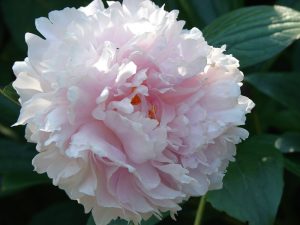To admire a peony in full bloom is a fitting way to celebrate our full arrival into spring and preview a hint of the colors that summer will bring to our gardens.
Although it is native to Asia, the peony has become a staple of Midwestern flower gardens – so much so that the Indiana Legislature in 1957 adopted the peony as the state flower. Zinnia was the state flower from 1931 to 1957 and the carnation prior to that. Though there have been recent efforts to replace the peony with a native species such as the fire pink as the state flower, the peony continues to hold the designation.
Peonies are hardy perennial plants that adapt easily to average garden conditions without much maintenance. There are two basic types of peonies that can be grown in the Midwest – garden (herbaceous) peonies and tree peonies. Garden peonies have thick, bushy foliage that reaches 2-4 feet in height and dies back to the ground each winter. Tree peonies are not truly tree-size but are generally larger than garden peonies and produce their annual growth from woody stems. They are generally a little less winter-hardy then the garden types.
Though there is a vast array of cultivars available, most gardeners are only familiar with the large, double-flowered garden forms in white, pale pink and magenta. In addition, garden peonies are available in single-flowered, semi-double, Japanese and anemone-type blossoms. Other colors include yellow, cream and red.
Tree peonies also come in single, semi-double and double-flowered forms, and the color range extends to include several shades of red and purple. Depending on the cultivar and weather conditions, peonies will blossom as early as April or as late as June. In many years the herbaceous peonies hit their peak bloom around Memorial Day, making them popular for gravesite plantings.
Peonies grow best in well-drained, sunny locations but can adapt to a wide range of soils. Garden peonies can be purchased as either potted plants or divisions of the tubers (underground stems). The more buds on the tuber, the faster the plant will make a good showing in the garden. Planting depth is critical for good garden performance. The buds of the tuber should be set no deeper than 2 inches below the soil surface. Peonies planted too deep will produce foliage each year, but they may never bloom.
Tree peonies are propagated either by seed or by grafting a certain cultivar onto a vigorous rootstock. Seed-grown plants usually require six or more years to become mature enough to flower. Grafted tree peonies generally bloom several years earlier.
Late summer or early autumn has long been the recommended planting time for both types of peonies. This allows the plants the opportunity to establish new root growth during the cooler, moister conditions. Spring planting is possible, but be prepared to pamper the plants throughout the stressful summer with about an inch of water per week and perhaps protection from hot afternoon sun.
Double-flowered forms often get so top heavy from the weight of the blooms that they bend over the ground and sometimes break off the stem. The flower stalks can be supported by tying them to a stake, surrounding them with a wire cage, or other support.
Peonies make excellent cut flowers for arranging indoors. Cut the stems early in the morning or late in the evening, when stems are filled with water. Choose stems with flower buds that are just beginning to show color; flowers that are already open will not last long in the vase.
The flower buds are loaded with fragrance and often have sticky sap, both of which help to attract pollinating insects. Unfortunately, the stickiness also attracts ants that you may not want to bring indoors. While popular garden legend says the ants are needed to open the flower buds, in fact, the ants do not perform any particular service for the flower, nor do they cause any harm. Apply a sharp spray of water from the garden hose to wash the ants away before bringing the flowers indoors.

